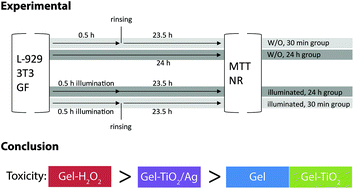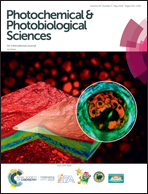In vitro evaluation of experimental light activated gels for tooth bleaching†
Abstract
Dental bleaching is an important part of aesthetic dentistry. Various strategies have been created to enhance the bleaching efficacy. As one such strategy, light-activated nanoparticles that enable localized generation of reactive oxygen species have been developed. Here, we evaluated the cellular response to experimental gels containing these materials in in vitro models. L-929 cells, 3T3 cells, and gingival fibroblasts were exposed to the gels at 50%, 10%, 2%, 0.4%, 0.08%, 0.016%, and 0.0032%. The gels contained TiO2/Ag nanoparticles, TiO2 nanoparticles, hydrogen peroxide (6% hydrogen peroxide), or no added component and were tested with and without exposure to light. Cells were exposed to gels for 24 h or for 30 min. The latter case mimics the clinical situation of a short bleaching gel exposure. Metabolic activity and cell viability were evaluated with MTT and neutral red assays, respectively. We found a dose-dependent reduction of formazan formation and neutral red staining with gels containing TiO2/Ag nanoparticles or TiO2 nanoparticles in the 24 h setting with and without illumination. The strongest reduction, which was not dose-dependent in the evaluated concentrations, was found for the gel containing hydrogen peroxide. Gels with TiO2 nanoparticles showed a similar response to gel without particles. TiO2/Ag gel showed a slightly higher impact. When the gels were removed by rinsing after 30 min of exposure without light illumination, gel containing TiO2/Ag nanoparticles showed a stronger reduction of formazan formation and neutral red staining than gel containing TiO2 particles. Exposure of cells for 30 min under illumination and consequent rinsing off the gels also showed that Ag-containing particles can have a higher impact on the metabolic activity and viability than particles from TiO2. Overall our results show that experimental bleaching gels containing TiO2/Ag or TiO2 nanoparticles are less cytotoxic than hydrogen peroxide-containing gel. When gels are removed, gel containing TiO2/Ag particles exhibit a stronger reduction of metabolic activity and viability than the gel containing TiO2.



 Please wait while we load your content...
Please wait while we load your content...